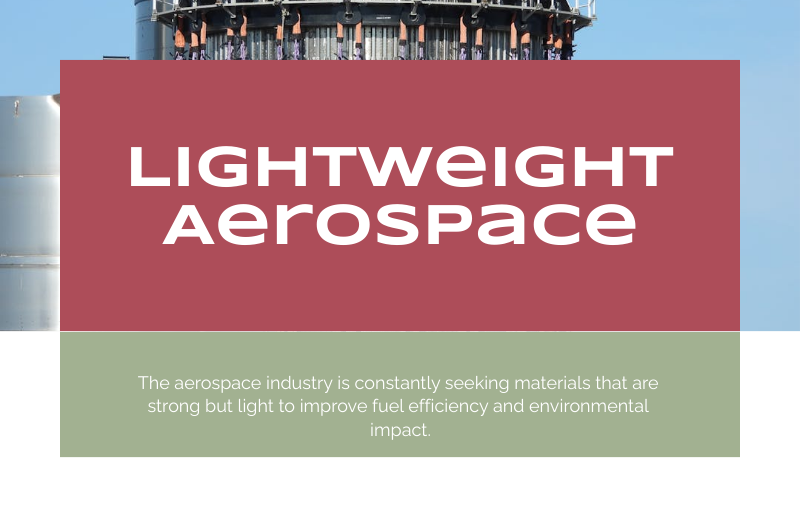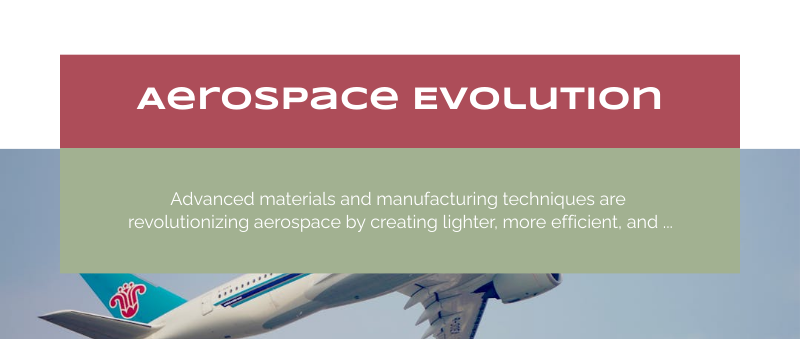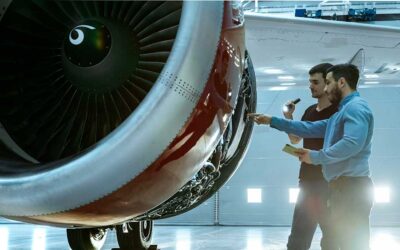The aerospace industry is in a constant quest for materials that can provide superior strength while significantly reducing weight. This drive is fueled by the demand for higher fuel efficiency, improved payload capacity, and reduced environmental impact. To meet these goals, manufacturers have turned to innovative materials and cutting-edge production processes. Advanced manufacturing techniques, such as additive manufacturing, friction stir welding, and automated fiber placement, are revolutionizing the way lightweight aerospace materials are designed and fabricated.
Why Lightweight Materials Matter in Aerospace
Weight reduction in aerospace isn’t just desirable—it’s essential. Each kilogram saved can lead to significant fuel savings and lower emissions over the aircraft’s lifespan. Furthermore, lighter materials enable better payload-to-weight ratios, which is crucial for both commercial and defense applications. This emphasis has spurred the adoption of high-performance materials like:
- Titanium alloys
- Aluminum-lithium alloys
- Carbon fiber reinforced polymers (CFRPs)
- Thermoplastics
- Ceramic matrix composites (CMCs)
The Shift Toward Advanced Manufacturing
Conventional manufacturing processes such as forging and machining, while reliable, often lead to material wastage and longer lead times. Advanced manufacturing techniques are redefining possibilities by enabling:
- Near-net-shape manufacturing
- Material efficiency
- Complex geometries
- Integrated functionalities
- Faster prototyping and production
Let’s explore some of the most transformative techniques shaping the future of aerospace manufacturing.
Additive Manufacturing (AM)
What It Is
Additive manufacturing, commonly known as 3D printing, builds components layer by layer from digital designs. In aerospace, AM is primarily used for:
- Rapid prototyping
- Complex, lightweight structures
- Custom tooling
Key Technologies
- Selective Laser Melting (SLM) and Electron Beam Melting (EBM) for metals like titanium and aluminum
- Fused Deposition Modeling (FDM) and Stereolithography (SLA) for plastics and composites
Advantages
- Enables design of intricate lattice structures reducing weight without compromising strength
- Minimizes material wastage
- Speeds up design-to-production cycles
Real-World Applications
NASA and SpaceX use AM for rocket engine components and structural elements, showcasing the durability and performance of 3D printed parts in extreme environments.
Automated Fiber Placement (AFP)
What It Is
AFP uses robotic heads to lay down composite fibers in precise patterns on a mold. It is widely used for creating large, complex aerospace structures like fuselage sections and wing components.
Benefits
- High strength-to-weight ratio
- Automation ensures repeatability and precision
- Reduced labor costs and production time
Materials Used
- Carbon and glass fiber pre-pregs
- Thermoset and thermoplastic matrices
Case Study
Boeing’s 787 Dreamliner heavily incorporates AFP-manufactured components, contributing to its 20% weight savings over conventional airliners.
Friction Stir Welding (FSW)
Technique Overview
FSW is a solid-state joining process ideal for aluminum and other low-melting-point metals. A rotating tool generates frictional heat that softens the metal and forges a joint without melting.
Benefits
- Produces high-strength, defect-free joints
- Minimal distortion due to lower heat input
- Ideal for joining dissimilar materials
Applications in Aerospace
FSW is used extensively in fabricating spacecraft fuel tanks, aircraft fuselages, and panels—critical areas where weld integrity is paramount.
Advanced Forming Techniques
Superplastic Forming (SPF)
SPF allows metals to be stretched into complex shapes at high temperatures. It’s used in forming titanium and aluminum alloy components with minimal spring-back.
Hot Isostatic Pressing (HIP)
HIP consolidates powder or cast components by applying high pressure and temperature. This method is vital for reducing porosity and increasing fatigue resistance in critical aerospace parts.
Precision Casting and Investment Casting
Investment casting enables the production of complex components with tight tolerances, often used for turbine blades and airframe fittings. Modern advancements allow the use of single-crystal techniques to enhance high-temperature performance and durability.
Hybrid Manufacturing
Combining multiple processes—like additive manufacturing with CNC machining or casting with FSW—yields high-performance, optimized structures. This integrated approach allows for:
- Enhanced material properties
- Greater design freedom
- Reduction in part count and assembly complexity
Digital Thread and Smart Manufacturing
Modern aerospace manufacturing integrates digital tools for design, simulation, and production oversight. Technologies include:
- Digital twins for real-time monitoring and predictive maintenance
- Machine learning for quality control
- IoT-connected machinery for process optimization
Challenges and Considerations
Despite its promise, advanced manufacturing in aerospace faces several hurdles:
- Certification: Especially in commercial aviation, each component must meet stringent regulatory standards.
- Cost: Initial investment in equipment and training can be high.
- Material Behavior: Understanding how new materials behave under stress, fatigue, and environmental conditions is crucial.
Integrating Machine Learning in Aerospace Manufacturing
Role of AI and Machine Learning
Artificial intelligence (AI) and machine learning (ML) are transforming aerospace production by optimizing processes, reducing defects, and accelerating innovation cycles. By analyzing large datasets from manufacturing environments, ML algorithms can:
- Predict equipment failures and schedule preventive maintenance
- Identify patterns in defect occurrences and suggest corrective actions
- Optimize tool paths and material deposition in additive manufacturing
Applications in Lightweight Material Production
- Quality Assurance: Vision systems powered by ML inspect parts in real time for deviations, ensuring uniformity in fiber placement and additive layers.
- Process Optimization: ML algorithms fine-tune process parameters such as laser power, feed rate, and temperature profiles to ensure optimal bonding and minimal porosity.
Sustainability in Aerospace Material Manufacturing
As the industry moves toward net-zero emissions, sustainable practices in materials and manufacturing are gaining traction.
Recycling and Reuse
- Recycled carbon fiber: Advances allow for reprocessing carbon fiber waste into usable reinforcements, reducing landfill waste.
- Metal powders: In additive manufacturing, unused metal powders can be sieved and reused, minimizing material costs and waste.
Bio-Based Composites
Research into bio-resins and natural fiber reinforcements (e.g., flax, hemp) offers a greener alternative to conventional composites. While not yet mainstream in aerospace, these materials are being tested for auxiliary and interior components.
Energy Efficiency
- Cold spray additive manufacturing (CSAM): A low-temperature alternative that uses kinetic energy to bond materials, significantly lowering energy consumption.
- Green manufacturing plants: Solar-powered facilities and smart energy management systems reduce the carbon footprint of aerospace production.
Industry Examples and Case Studies
Airbus
Airbus uses AFP and AM extensively across its product lines. The A350 XWB features over 50% composite materials, which are largely fabricated using automated processes. The company’s use of generative design and topology optimization has led to weight reductions and part count minimization.
Lockheed Martin
Lockheed Martin has adopted friction stir welding in its Orion spacecraft and has invested in digital twins to simulate and monitor manufacturing processes. These initiatives reduce costly rework and ensure mission-critical quality standards are met.
GE Aviation
GE is a pioneer in using additive manufacturing for jet engine components like fuel nozzles. The LEAP engine’s fuel nozzle, produced using direct metal laser sintering, consolidated 20 parts into one, cutting weight by 25% and enhancing performance.
Future of Advanced Aerospace Manufacturing
Topology Optimization
This technique uses algorithms to design parts with material placed only where necessary, reducing weight while maintaining strength. It’s especially beneficial when combined with 3D printing.
In-Space Manufacturing
NASA and private spaceflight companies are exploring manufacturing in microgravity. This could revolutionize how parts are produced and repaired in orbit, using in-situ resources and additive techniques.
Integrated Sensors and Smart Materials
Future aerospace structures will embed sensors and actuators within the material itself. These “smart structures” can self-monitor for damage, adapt to aerodynamic loads, or even self-heal minor cracks.
Advanced Manufacturing Methodologies for Low-Density Aerospace Materials.
The integration of advanced manufacturing techniques into aerospace design and production is a defining feature of 21st-century engineering. By embracing innovation in materials, processes, and digital technologies, the aerospace industry is building the next generation of lighter, more efficient, and more sustainable flight systems.
From additive manufacturing and friction stir welding to machine learning and sustainability initiatives, these techniques are not just enhancing performance—they’re reshaping the very possibilities of flight. As we continue to push the boundaries of what’s possible, the synergy between material science and manufacturing innovation will remain at the heart of aerospace advancement.







